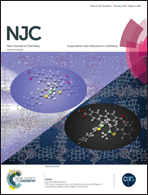MoO2Cl2 catalyzed efficient synthesis of functionalized 3,4-dihydropyrimidin-2(1H)-ones/thiones and polyhydroquinolines: recyclability, fluorescence and biological studies†
Abstract
A simple, facile and efficient synthesis of functionalized dihydropyrimidinones and polyhydroquinolines using molybdenum(VI) dichloride dioxide (MoO2Cl2) has been developed. The present protocol demonstrates the exceptional tolerance towards acid labile protecting groups such as tert-butyl dimethyl silyl (TBDMS) and tert-butyl diphenyl silyl (TBDPS). This is the first report of exploring Lewis acid properties of MoO2Cl2 in the diversity oriented synthesis of Biginelli and Hantzsch reactions. Biologically important and highly structured conjugates of dihydropyrimidinone and polyhydroquinoline derivatives containing coumarin, pyrazole, indole and triazole moieties were synthesized in good to excellent yields. Compound 4o exhibited blue fluorescence at a maximum UV absorbance λmax of 326 nm. In the preliminary MTT [3-(4,5-dimethylthiazol-2-yl)-2,5-diphenyltetrazolium bromide] assay, compound 4n displayed remarkable cytotoxic activity against A549 and PC3 cell lines while compound 7q was found to be cytotoxic against HGC-27 and PC3 cancer cell lines.


 Please wait while we load your content...
Please wait while we load your content...